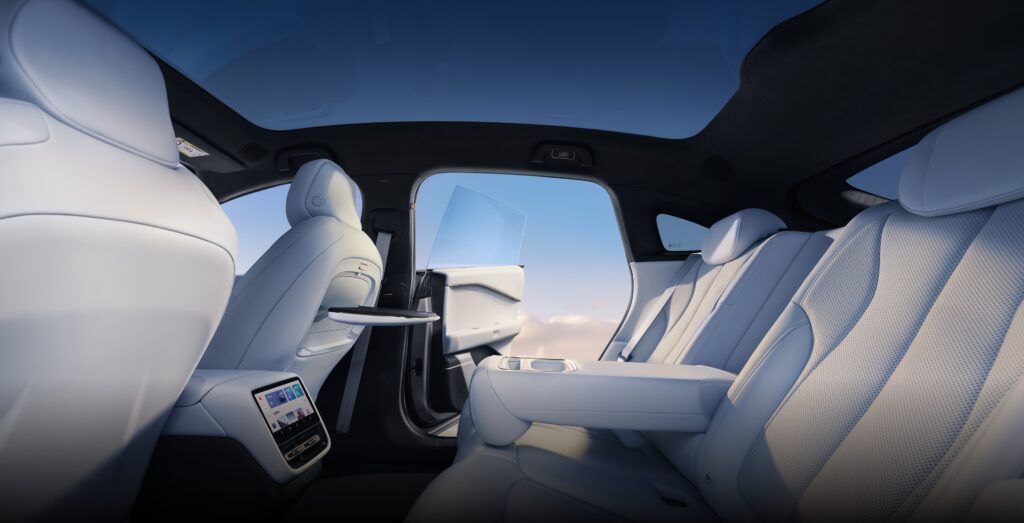
The XPENG P7+ has officially been launched, positioned as a mid-to-large-sized sports sedan that blends personalized styling with the need for family-friendly spaciousness. The new car’s front end adopts the family design, combining split headlight clusters with a through-type daytime running light, exuding both a sense of technology and sportiness.
Compared to the P7, the XPENG P7+ introduces innovations in its rear design, featuring a dual-tone sloping roof design that emphasizes cabin space. With an impressive drag coefficient of just 0.206Cd, it demonstrates excellent aerodynamic performance. The rear of the car sports a through-type tail light that echoes the front design, along with dual rear spoilers and a rear bumper in a contrasting color, highlighting its sporty style.

The interior is simple yet technological, making extensive use of soft aqueous PU materials for a comfortable ride. The new car boasts an abundance of storage space, with a total of 33 compartments and up to 8 mobile phone slots. It is equipped with luxurious features such as dual 50W wireless phone charging pads, a 20-speaker HiFi audio system, starburst ambient lighting, and full-car seat ventilation, heating, and massage functions, enhancing the riding experience.
In terms of intelligent driving, the XPENG P7+ is equipped with a brand-new AI Eagle Eye Vision system, significantly improving perception and recognition speeds. The cockpit is equipped with a 15.6-inch 2.5K high-resolution central control screen powered by the Qualcomm Snapdragon SA8295P automotive-grade chip for smooth operation. The instrument screen measures 10.25 inches, the streaming rearview mirror is 9 inches, and the rear entertainment control screen is 8 inches, catering to passengers’ entertainment needs.
For power, the XPENG P7+ offers a rear-wheel-drive single-motor system with high and low-power versions of 230kW and 180kW respectively, capable of reaching a top speed of 200km/h. In terms of battery life, it is equipped with lithium iron phosphate battery packs in two capacities: 60.7kWh and 76.3kWh, providing ranges of 620km and 710km respectively, meeting daily travel requirements.

What are ESD components, and what is their importance in mobile phones? The significance of built-in ESD components.
ESD components are specialized electronic components designed to protect electronic devices from the effects of electrostatic discharge (ESD). Electrostatic discharge is a sudden release of electrical charge that can potentially damage electronic devices, leading to device malfunctions or a shortened lifespan. ESD components are designed to absorb, conduct, or dissipate electrostatic discharges to prevent damage caused by static electricity.
In mobile phones, the primary role of ESD components is to protect the internal electronic components from the harm caused by electrostatic discharge. Various circuits and components inside the phone are highly sensitive to ESD, which is why multiple ESD components are typically used in the phone’s design to provide protection. These components may include diodes, ESD diode, MOSFET and more.
Specifically, ESD components in a mobile phone may serve the following purposes:
Interface Protection: Various interfaces of the phone, such as the charging port and headphone jack, may require ESD components to prevent damage from electrostatic discharge.
RF Circuit Protection: RF circuits in mobile phones are highly sensitive to ESD and require ESD components to safeguard these critical circuits.
Processor and Memory Protection: Processors, memory, and other crucial components in the phone also require ESD protection to ensure the device’s normal operation.
Touchscreen and Display Protection: The touchscreen and display are integral parts of a mobile phone that also require ESD components to prevent static electricity damage.
In summary, ESD components play a crucial role in protecting the internal electronic components of a mobile phone from damage caused by electrostatic discharge, ensuring the phone’s proper operation and longevity.